LYNN CHADWICK (UK, 1914–2003)
Perhaps the most famous British artist of the 1960s, Lynn Chadwick is known mostly for his large sculptures of steel and bronze. His work is in the collections of MOMA in New York, The Tate in London, and the Centre Georges Pompidou in Paris, among many.
In 1965, he launched his Moon Series A through F. This piece is from the initial A series. It is #34 of the 70 printed. In addition to its sibling from the A series that resides in The Tate, London, Chadwick's Moon series prints are in the collections of The Brooklyn Museum, Atlanta's High Museum of Art, Buffalo's AKG Art Museum, and others.
Lynn Chadwick remains the most exciting of all the artists to emerge in the post-war period in Britain. He won the international prize for sculpture at the Venice Biennale of 1956, becoming the youngest-ever recipient of this prestigious prize; such a triumph early in his career catapulted him overnight into being a major sculptor of the 20th century.
In the 1930s, Chadwick worked as an architectural draughtsman up until the Second World War, when he served as a pilot in the Fleet Air Arm. Subsequently, he succeeded in branching out as an independent sculptor. He focused on his kinetic works, characterized by sensuous moves that, undulating and rotating through space, could create virtual forms. These animated structures progressed in a varied and evolutionary process that culminated in an urgent need to make the implied forms solid. In 1950, Chadwick reached, through his newly acquired welding skills, his unique means of expression, “drawing in space”, in which he welded his steel rods together in triangulated structures and subsequently filled the voids between the lines with a mixture of iron filings and gypsum.
Uninhibited by the constraints of formal art education, Chadwick freely and instinctively invented images from his imagination, utilizing his individual technique and creating a fantastic oeuvre of novel human and animal forms. His international recognition led to a dizzying program of exhibitions and museum shows, private as well as public commissions.
The 1970s and 80s saw further advancements and metamorphoses into a faceted figuration, imposing beings with winged or robed bodies perched on slender, tapered legs. He also channeled the essence of his own earlier mobiles in art of motion, balance and stance in pursuit of a kind of body language that Chadwick himself described as ‘Attitude’. The 1990’s saw the reinterpretation of beasts and coupled with the ineffable attitude of Chadwick’s earlier inventions in the reflective panels of sheet stainless steel, including a final reworking of the mobile form on a monumental scale.
After a career that spanned five decades, Lynn Chadwick made his last work, Ace of Diamonds, in 1996. He passed away in 2003, the year Tate Britain devoted a major retrospective to him.
In the 1930s, Chadwick worked as an architectural draughtsman up until the Second World War, when he served as a pilot in the Fleet Air Arm. Subsequently, he succeeded in branching out as an independent sculptor. He focused on his kinetic works, characterized by sensuous moves that, undulating and rotating through space, could create virtual forms. These animated structures progressed in a varied and evolutionary process that culminated in an urgent need to make the implied forms solid. In 1950, Chadwick reached, through his newly acquired welding skills, his unique means of expression, “drawing in space”, in which he welded his steel rods together in triangulated structures and subsequently filled the voids between the lines with a mixture of iron filings and gypsum.
Uninhibited by the constraints of formal art education, Chadwick freely and instinctively invented images from his imagination, utilizing his individual technique and creating a fantastic oeuvre of novel human and animal forms. His international recognition led to a dizzying program of exhibitions and museum shows, private as well as public commissions.
The 1970s and 80s saw further advancements and metamorphoses into a faceted figuration, imposing beings with winged or robed bodies perched on slender, tapered legs. He also channeled the essence of his own earlier mobiles in art of motion, balance and stance in pursuit of a kind of body language that Chadwick himself described as ‘Attitude’. The 1990’s saw the reinterpretation of beasts and coupled with the ineffable attitude of Chadwick’s earlier inventions in the reflective panels of sheet stainless steel, including a final reworking of the mobile form on a monumental scale.
After a career that spanned five decades, Lynn Chadwick made his last work, Ace of Diamonds, in 1996. He passed away in 2003, the year Tate Britain devoted a major retrospective to him.
Born in 1914 in London, United Kingdom
Died in 2003 in Stroud, United Kingdom
Died in 2003 in Stroud, United Kingdom
